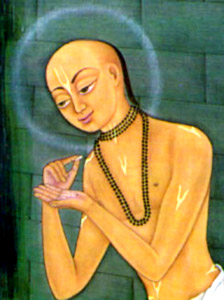Classical Vaisesika theory of number states that numbers are qualities of substances. Number is a separate category, not a kind of quality, as there is possession of that number in qualities and so on. And this judgment is not an erroneous one, for there is no other judgment which contradicts it. As per the Vaisesika theory, a quality `two` inheres in both members of a pair of substances, another quality `two` inheres in another such pair, and all the qualities `two` have inhering in them a single universal `two-hood`. According to the theories of Indian philosophers Bhasarvajna and Raghunatha, numbers are not qualities at all, but relations of identity and difference.
 Raghunatha is more radical regarding this theory. The central problem is that things in any category in the Vaisesika ontology can be numbered, and Raghunatha concludes that numbers must belong in a new category of their own. Raghunatha puts that the number relation is not reducible to the relation of inherence or any relation constructed out of it, for it is a relation between numbers and any type of thing. Raghunatha points out that while inherence is a distributive relation, the number-thing relation has to be collective. The distinction occurs in the context of sentences with plural subjects. An attributive relation is distributive if it relates the attribute to every subject - if the trees are old, then each individual tree is old. A relation is collective if it relates the attribute to the subjects collectively, but not individually such as the trees form a forest does not imply that each tree forms a forest. Number attributions are collective; if one says that there are two pots here, one does not imply that each pot is two. Inherence, however, is a distributive relation, and so cannot be the relation of attribution for numbers. This new relation is called the `collecting relation` by Raghunatha. The collecting relation, whose existence is indicated by constructions such as `this is one pot` and `these are two`, is a special kind of self-linking relation.
Raghunatha is more radical regarding this theory. The central problem is that things in any category in the Vaisesika ontology can be numbered, and Raghunatha concludes that numbers must belong in a new category of their own. Raghunatha puts that the number relation is not reducible to the relation of inherence or any relation constructed out of it, for it is a relation between numbers and any type of thing. Raghunatha points out that while inherence is a distributive relation, the number-thing relation has to be collective. The distinction occurs in the context of sentences with plural subjects. An attributive relation is distributive if it relates the attribute to every subject - if the trees are old, then each individual tree is old. A relation is collective if it relates the attribute to the subjects collectively, but not individually such as the trees form a forest does not imply that each tree forms a forest. Number attributions are collective; if one says that there are two pots here, one does not imply that each pot is two. Inherence, however, is a distributive relation, and so cannot be the relation of attribution for numbers. This new relation is called the `collecting relation` by Raghunatha. The collecting relation, whose existence is indicated by constructions such as `this is one pot` and `these are two`, is a special kind of self-linking relation.
The account of number affords an instructive insight into the mechanisms of theory-change and internal criticism in Indian philosophical thinking. The classical Vaisesika theory of number was modified under pressure from within, through assimilation of the categories of quality and motion, elimination of the category of differences, and introduction of a new category of number. The old theory failed because it supplied no explanation of a range of observed facts about the actual application of the concept of number, in particular that the concept is applicable to objects in any ontological category. The process of rejection and revision was driven, then, by a perceived mismatch between the older theory of a concept and the actual use of that concept in a range of cases. However, the idea of rational acceptability as foundational coherence is not the active principle behind the rejection or revision of Vaisesika metaphysical theory of numbers.












